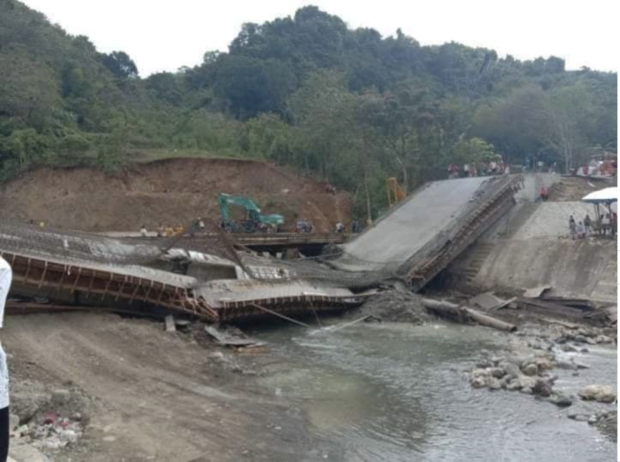Pimentel asks DPWH: Local bridges are collapsing, can’t you offer help?

An under construction bridge in Barangay Magsaysay, Davao City collapsed on February 18. According to initial reports, two workers were injured in the incident. 📸: Team Davao Rescue/Facebook
MANILA, Philippines — Can’t the Department of Public Works and Highways (DPWH) offer any help to the local government units where bridges have collapsed?
This was the question posed by Senate Minority Floor Leader Koko Pimentel on Thursday, as the Senate finance subcommittee was discussing the agency’s proposed budget for 2022.
During the hearing, Pimentel asked DPWH Secretary Manuel Bonoan about four bridges that have collapsed recently — Borja Bridge in Catigbian, Bohol; Loay Bridge in Loay, Bohol; Kulafu River Bridge in Davao City; and a bridge in Majayjay, Laguna.
In response, Bonoan said all four were local bridges, and therefore were not under the jurisdiction of the DPWH. Pimentel was unsatisfied however, asking DPWH why it has not extended any assistance to local government units (LGUs) about the construction of these bridges especially when lives are at stake.
“So local bridges are collapsing. Paano ang standard nitong mga ‘to (What is the standard here)? Does the DPWH even extend any assistance on the specifications, the safety?” the senator asked.
Article continues after this advertisementBonoan said that bridges, regardless of whether they are made by the DPWH or the local governments, should follow a standard design set by the department to ensure its safety and durability.
Article continues after this advertisement“They are supposed to use the same standards, your Honor. And we share them, we have furnished actually all the local government units on design standards of bridges actually. But of course they have their own engineering units that prepare their design and implement their projects, your Honor,” he said.
“For locally infrastructure projects, (it) is almost the same as what we implement in the national level,” he added.
Pimentel asked again if DPWH renders technical advice to the local governments since the bridges are still part of the country’s overall infrastructure. Bonoan said they do not, but assured the senators that they would contact LGUs about it.
Furthermore, the DPWH chief said they have taken over the construction of some of the bridges that collapsed.
“Unfortunately, I don’t think we do that, your honor. So perhaps I think we can liaise with the local government in the process of ascertaining the structural integrity of the (bridges),” Bonoan said.
“I have just been informed. Yes this is a bridge that collapsed actually during construction and DPWH took over actually to implement the reconstruction of the bridge, your Honor,” he added, referring to the Kulafu bridge in Davao City.
https://www.facebook.com/inquirerdotnet/photos/pcb.10162013080034453/10162013064284453/?type=3&theater
However, Pimentel raised concerns as to why bridges that were constructed or reconstructed by DPWH are still considered as ‘local bridges’ — speculating that the collapsed bridges may have undergone DPWH intervention already but the department is feigning responsibility.
Due to the confusion, Pimentel just asked Bonoan to submit a written report to the Senate committee.
Aside from infrastructure costs, lives have been lost in the several incidents mentioned by Pimentel. While no one was hurt when the Borja bridge collapsed last June 16, four were reported dead after the Loay bridge collapsed on April 27. With reports from Trisha Manalaysay, INQUIRER.net trainee
RELATED STORIES:
BREAKING: Another bridge in Bohol collapses
4 killed, 15 rescued as bridge in Bohol collapses